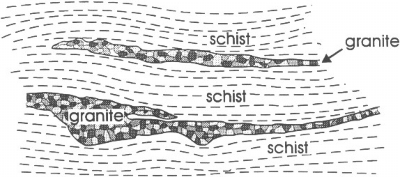

Below are a few geologic features that occur along the Great Unconformity Geologic Interpretive Trail. Imagine yourself walking up a steep, rocky trial that crosses back and forth between the ancient Precambrian basement rocks and the younger Tapeats Sandstone. Grab your hat and a canteen of water, and let's go!
Stop 1: Granite and Schist


Igneous rocks crystallize from hot, liquid rock called magma. In the exposure shown above, the light-colored bands of rock with large crystals are called granite, a type of igneous rock that forms when magma cools slowly deep within the Earth.
The darker rock with tiny crystals is called schist, a type of metamorphic rock. Metamorphic rocks form by the alteration of pre-existing rocks under intense heat and pressure, but they don't pass through a liquid state.
Stop 2: Recycled Quartz and Rock Varnish
 The trail has taken us across the Great Unconformity into the Tapeats Sandstone. Sandstone is a sedimentary rock. Notice the large, light gray, angular, quartz pebbles. These pebbles were originally igneous quartz crystals that crystallized from magma 1.7 billion years ago. For 1.2 billion years they sat within the crust of the Earth until they were finally exposed on the Earth's surface about half a billion years ago, probably by a river eroding into the Precambrian basement complex. The river carried the quartz crystals to the sea, where they were tumbled and abraded by the waves, eventually coming to rest as pebbles within the Tapeats Sandstone. For 500 million years they have been biding their time within this sandstone, patiently waiting for their next adventure to begin. Very soon (geologically speaking) they will be on their way once again as the face of Frenchman Mountain erodes away.
The trail has taken us across the Great Unconformity into the Tapeats Sandstone. Sandstone is a sedimentary rock. Notice the large, light gray, angular, quartz pebbles. These pebbles were originally igneous quartz crystals that crystallized from magma 1.7 billion years ago. For 1.2 billion years they sat within the crust of the Earth until they were finally exposed on the Earth's surface about half a billion years ago, probably by a river eroding into the Precambrian basement complex. The river carried the quartz crystals to the sea, where they were tumbled and abraded by the waves, eventually coming to rest as pebbles within the Tapeats Sandstone. For 500 million years they have been biding their time within this sandstone, patiently waiting for their next adventure to begin. Very soon (geologically speaking) they will be on their way once again as the face of Frenchman Mountain erodes away.
These rocks have a dark coating called desert varnish or rock varnish. Rock varnish is a thin manganese- and iron-rich coating that develops on exposed rock surfaces, especially in deserts. The varnish is apparently produced by bacteria using chemicals from dust particles. It takes thousands of years for a dark layer of varnish to develop.
Stop 3: Sandstone with an Attitude
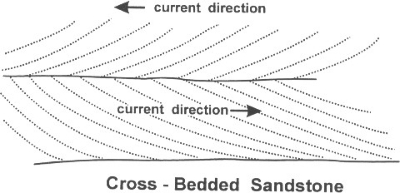
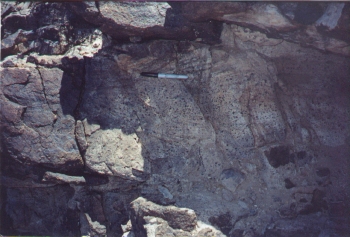
Stop 4: Nature's Air Conditioner
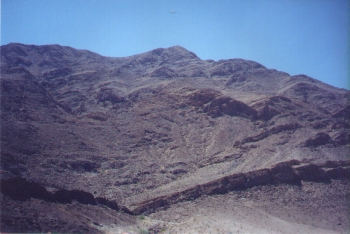 The western face of Frenchman Mountain is a continuous exposure of sedimentary rock layers totaling more than 4,000 feet (1,200 m) in thickness. Most of the layers in Frenchman Mountain are either limestone (calcium carbonate) or dolomite (calcium-magnesium carbonate). These two rock types are collectively called carbonate rocks. Carbonate rocks are sedimentary rocks that form on the shallow seafloor, usually due to the activities of organisms.
The western face of Frenchman Mountain is a continuous exposure of sedimentary rock layers totaling more than 4,000 feet (1,200 m) in thickness. Most of the layers in Frenchman Mountain are either limestone (calcium carbonate) or dolomite (calcium-magnesium carbonate). These two rock types are collectively called carbonate rocks. Carbonate rocks are sedimentary rocks that form on the shallow seafloor, usually due to the activities of organisms.
An important characteristic of carbonate rocks is that they contain abundant carbon. Each atom of carbon trapped in a carbonate rock is one fewer molecule of carbon dioxide (a greenhouse gas) in the atmosphere. If it weren't for carbonate rocks, Earth would long ago have experienced "runaway greenhouse" conditions, such as on Venus. All of the carbon trapped in the 4,000 feet of carbonate rock in Frenchman Mountain helps make Earth a livable planet. Have you thanked a carbonate rock today?
Stop 5: The Overlook
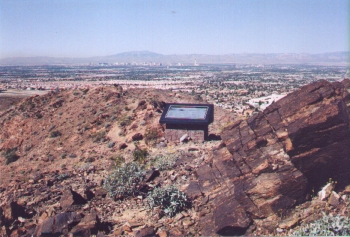 You are looking westward across the Las Vegas Valley. Like a bathtub full of rocks, the Las Vegas Valley is a deep basin filled with gravel, sand, and clay. This material eroded off of the surrounding mountains during the past several million years. This basin of sediments is more than 3,000 feet (1,000 m) deep. Rainfall on the valley floor averages only about 4 inches (10 cm) per year, but the high peaks receive more than 20 inches (50 cm). Some of the rain that falls in the spring mountains percolates down into the basin and collects in the spaces between the rocks and sand grains. Before people began to pump water from the ground in the 1920s, the bathtub overflowed in the form of natural springs. The flow from Las Vegas Springs, in the center of the valley, created a marsh and meadow environment that gave the valley its name--Las Vegas--the meadows.
You are looking westward across the Las Vegas Valley. Like a bathtub full of rocks, the Las Vegas Valley is a deep basin filled with gravel, sand, and clay. This material eroded off of the surrounding mountains during the past several million years. This basin of sediments is more than 3,000 feet (1,000 m) deep. Rainfall on the valley floor averages only about 4 inches (10 cm) per year, but the high peaks receive more than 20 inches (50 cm). Some of the rain that falls in the spring mountains percolates down into the basin and collects in the spaces between the rocks and sand grains. Before people began to pump water from the ground in the 1920s, the bathtub overflowed in the form of natural springs. The flow from Las Vegas Springs, in the center of the valley, created a marsh and meadow environment that gave the valley its name--Las Vegas--the meadows.
Imagine standing at this spot 20,000 years ago during the last cold interval of the Pleistocene Ice Age. The mountain crests were white with snow, and the valley was green with meadows and marshes. Instead of hotels and houses, you would have seen heards of mammoths, camels, horses, and bison grazing in the valley below, and maybe a giant ground sloth browsing on the ridge in the foreground. Imagine a pair of large Pleistocene American lions stalking a bison way out there where the asphalt of Lake Mead Blvd. disappears in a sea of red tile roofs. Imagine giant condors circling in the sky, ready to pick the bones of the fallen prey.
What dramatic changes have occurred here in the past 20,000 years! Change is constantly occurring on Earth and among its inhabitants. The mountains and basins of Southern Nevada and the plants and animals that live here (including us), represent only the latest chapter in the complex geological and biological evolution of this region.
Please watch your step as you head back down the steep trail.